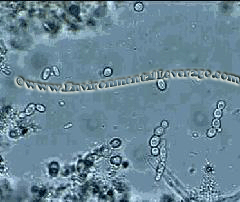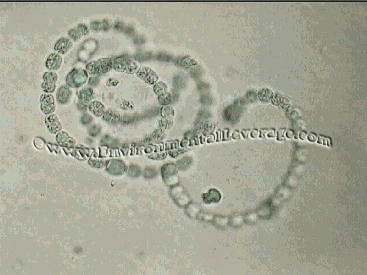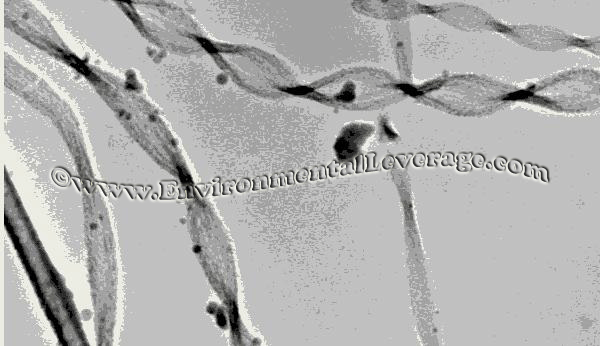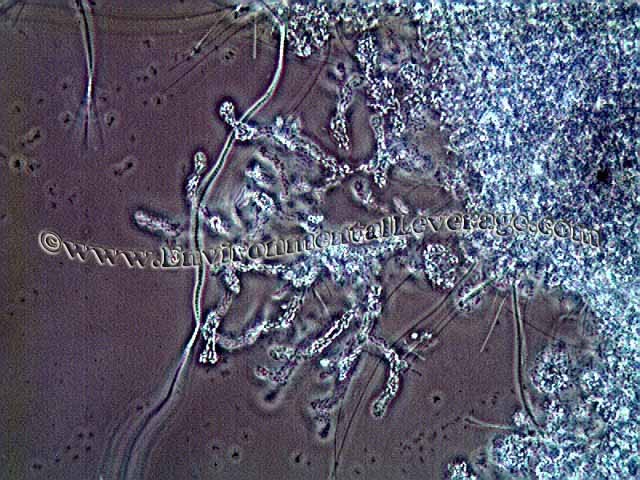Biological Products:
Bioaugmentation products for Wastewater applications in Papermills, Refineries, Chemical, Tanneries, Municipalities, Textiles, Steel, Agriculture, Animal feedlot, Gun Powder plant, Food and Beverage- Dairy Products, Orange Juice factory, Wineries, Cookie factory, Vegetable processing plant, Meat packing, Barbecue Restaurant, Aquaculture, Ornamental Ponds with algae , CAFO, Nursing homes, Military, Campgrounds, Universities, Regulatory agencies, River and Lake remediation
Lab Services:
Filamentous Identification Lab Service. One reason to identify filaments is to determine the filaments characteristics and then determine the type present. If the type is found out, a root cause can usually be associated with a particular filament. If the cause is known, then a correction can be made to alleviate problems. Chlorination is only a quick fix. Without process changes, filaments will grow back after chlorination. Wastewater Biomass Analyses and Cooling Tower Analyses also available
Training Materials:
Training is an integral part of any job. Not everyone is at the same level of training. Many people want beginning concepts and basics. Some need technical information or troubleshooting. Some want equipment, technology or process information. We have developed a full set of Basic training, Advanced training, Filamentous Identification the Easy Way as well as custom training CD's Manuals. We also provide hands-on training classes and soon will have an Online "E-University".
Audits and Consulting:
At Environmental Leverage® Inc., we have a team of experienced individuals who come into your plant with a fresh pair of eyes. The system is checked from influent to effluent. System optimization, equipment efficiency and operational excellence are key components explored. Key Benefits Equipment efficiency Total Cost of Operation reductions Reliability and safety An onsite audit is conducted to examine system parameters, process controls, and current monitor and control procedures. A physical walk-through is conducted, process flow diagrams are examined, previous design criteria are examined and current standard operating procedures are evaluated along with data logs.
|
Service OptionsLatest News!
What's New!
We have just added "Virtual Audits" to our capabilities. Check out our new Services. We are in the process of developing new courses for our ""Online E-University" in order to meet the needs of our global customers that cannot travel to our public classes.Visit our new website www.WastewaterElearning.com/Elearning Cooling Tower Microbiological Water Analyses
What are the typical Biological species found that could cause corrosion
and Biofouling?
Fungi Mold Yeast Algae Aerobic and
anaerobic bacteria MIC bacteria
(sulfate-reducing, acid producing, nitrate reducing, Iron/sulfur
oxidizing) Slime-forming
bacteria
Iron/manganese depositing bacteria
Thiobacillus spp., Gallionella spp., Sphaerotilus spp.
Yeast and Fungi
Fungi
Yeast
Identification: Yeast are a
group of unicellular fungi a few species of which are commonly used to
leaven bread and ferment alcoholic beverages. Most yeast belong to the
division Ascomycota.
Algae
What
type of Algae are you growing in your cooling tower?
Algae can be curled or in small free floating clusters with a slime coating
Anabaena Woronichinia naegeliana  
Achnantes taeniata is a brown algae Filamentous Blue Green algae or cyanobacteria and Beggiatoa
Aphanizomenon flos-aquae Scenedesmus and Flagellate
Branched algae Algae growing on cement and metal railings
Diatoms Diatoms are algae enclosed by a silicaceous cell wall and may also be present in cooling towers but generally do not play a significant role in cooling system problems.
Microbiological Influenced Corrosion or MIC MIC is corrosion or deterioration of material, which is initiated and/or accelerated by the activities of micro-organisms. These materials are mainly metal, but also can be concrete or plastics. 1/5 of all corrosion is typically caused by microorganisms and biofouling. The most common MICs can be categorized into sulphate reducing bacteria (SRB), iron oxidizing bacteria and acid producing bacteria (APB).
can include Desulfovibrio, Purple sulfur bacteria, Beggiatoa, Thiobacillus, Spaeratolis Natans SRBs are characterized by hydrogen sulfide odor and blackened water or black colored deposits. Iron oxidizing bacteria generally form in filamentous clumps and can be detected under microscope by their distinct appearance due the excreted products that grow. This corrosion by iron bacteria often forms tubercles.
Beggiatoa is a motile sulfur reducing filamentous Bacteria found in many biofilms DesulfoVibrio Spirillum
Purple sulfur bacteria Spirillum and S natans
S. natans Filaments with sulfur granules
Iron Depositing Bacteria Iron depositing bacteria grow best in low oxygen environments but are
common in open-circulation systems. Gallionella and Gallionella spp.,
Biofouling Slime or Slime forming Bacteria
As you can see, there are quite a few different things that can be determined under the microscope from Cooling tower water samples. Many things can be determined that can save time, money and reduce multiple traditional tests. Call our lab to find out how to schedule a microscopic analyses of your cooling tower water or slime that has built up. 630-906-9791 Ask for Jenny or Laurie to set up a sample analyses as we have multiple lab locations.
|

 Cooling towers can be a critical process in many industrial production
facilities.
Cooling towers can be a critical process in many industrial production
facilities. Biofouling
can also destroy cooling towers if they are made of lumber. Corrosion can
occur on metal parts.
Biofouling
can also destroy cooling towers if they are made of lumber. Corrosion can
occur on metal parts.  The
presence of large amounts of yeast or fungi can indicate a low pH, or
existence of fermentative conditions. There are more than 75,000 species of
yeast and fungi, which include mold, smut, rust and mildew. They may be
colorless or cover the entire color spectrum. Most grow best in warm, dark,
moist places. Most are aerobic with low oxygen demand. A few, including
yeast, are anaerobic. Fungi can grow on almost any surface and are
considered an attributing factor to wood deterioration. Both yeast and fungi
are commonly transported by air currents. They are relatively large and can
easily be identified with microscopic analyses.
The
presence of large amounts of yeast or fungi can indicate a low pH, or
existence of fermentative conditions. There are more than 75,000 species of
yeast and fungi, which include mold, smut, rust and mildew. They may be
colorless or cover the entire color spectrum. Most grow best in warm, dark,
moist places. Most are aerobic with low oxygen demand. A few, including
yeast, are anaerobic. Fungi can grow on almost any surface and are
considered an attributing factor to wood deterioration. Both yeast and fungi
are commonly transported by air currents. They are relatively large and can
easily be identified with microscopic analyses.
 Two forms of fungi commonly encountered are molds (filamentous forms) and
yeast (unicellular forms). Molds can be quite troublesome, causing white rot
or brown rot of the cooling tower wood, depending on whether they are
cellulolytic (attack cellulose) or lignin degrading. Yeast are also
cellulolytic. They can produce slime in abundant amounts and preferentially
colonize wood surfaces.
Two forms of fungi commonly encountered are molds (filamentous forms) and
yeast (unicellular forms). Molds can be quite troublesome, causing white rot
or brown rot of the cooling tower wood, depending on whether they are
cellulolytic (attack cellulose) or lignin degrading. Yeast are also
cellulolytic. They can produce slime in abundant amounts and preferentially
colonize wood surfaces.
 Algae
primarily occur in the tower deck area because most species require sunlight
for photosynthesis and growth.
Algae
primarily occur in the tower deck area because most species require sunlight
for photosynthesis and growth.











.jpg)











 Sphaerotilus use soluble, or ferrous, iron as an energy source, and convert
it to an insoluble oxide or hydroxide form. These deposits create fouling
and set up concentration corrosion cells and conditions under which
anaerobic bacteria flourish. Gallionella frequently leave spiderweb-like
deposits on metal surfaces. The deposit looks like black iron. Severe
corrosion is usually evident under the deposit.
Sphaerotilus use soluble, or ferrous, iron as an energy source, and convert
it to an insoluble oxide or hydroxide form. These deposits create fouling
and set up concentration corrosion cells and conditions under which
anaerobic bacteria flourish. Gallionella frequently leave spiderweb-like
deposits on metal surfaces. The deposit looks like black iron. Severe
corrosion is usually evident under the deposit.  Other
bacteria that may be present in cooling water include Pseudomonas,
Klebsiella, Eneterobacter, Acinetobacter, Bacillus, Aeromonas, and
Legionella Spore forming bacteria Denitrifying bacteria, or pseudomonas, can
cause the loss of nitrite inhibitor in closed-water systems. Usually plate
counts with differential media are used to determine the exact count of
these types of bacteria
Other
bacteria that may be present in cooling water include Pseudomonas,
Klebsiella, Eneterobacter, Acinetobacter, Bacillus, Aeromonas, and
Legionella Spore forming bacteria Denitrifying bacteria, or pseudomonas, can
cause the loss of nitrite inhibitor in closed-water systems. Usually plate
counts with differential media are used to determine the exact count of
these types of bacteria 








